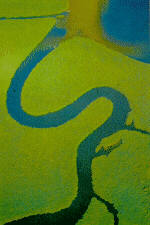About Amazonia
Sub-Menu
|
 Introduction Introduction
Amaz˘nia is one of the largest wilderness areas left
on earth – over six million square kilometres of
river and jungle. It takes up much of South America,
covering a large portion of Brazil, and parts of
neighbouring Peru, Bolivia, Colombia, Venezuela, Ecuador,
and the Guyanas. Most of this area is tropical rainforest
containing exotic birds, monkeys, jaguars, and even
remote tribes of Amazon Indians.
Amaz˘nia (also called the Amazon Basin) is named
after the huge river that flows through it. The Amazon
river is over 6,000 km long, and is one of over a
thousand other rivers in Amaz˘nia (17 of which are over
1,500 km long). The Amazon river is so big that
oceanliners and cargo ships can sail upstream to the port
of Iquitos, located at the foot of the Andes mountains in
Peru, more than 3,500 km from the Atlantic coast.
One-fifth of all the flowing freshwater in the world
(excluding water locked up as ice in Antarctica) flows
through the Amazon river.
 Amaz˘nia
is very important because it contains much of the world's
plant and animal life. About one-third of all the
different types of plants and animals on earth live in
Amaz˘nia, and many are found nowhere else. There aren't
any really big animals such as elephants and giraffes,
but there are lots of smaller animals such as jaguars,
monkeys, ant-eaters, sloths, and a huge variety of
insects. In the rivers there are crocodiles, piranha,
giant catfish, and even pink dolphins. Amaz˘nia
is very important because it contains much of the world's
plant and animal life. About one-third of all the
different types of plants and animals on earth live in
Amaz˘nia, and many are found nowhere else. There aren't
any really big animals such as elephants and giraffes,
but there are lots of smaller animals such as jaguars,
monkeys, ant-eaters, sloths, and a huge variety of
insects. In the rivers there are crocodiles, piranha,
giant catfish, and even pink dolphins.
Amaz˘nia's huge variety of plants is of special
interest to scientists. Many of the medicines that we
rely on are made using extracts from tropical plants, and
scientists think that there are many new medicines
waiting to be discovered as they study and learn more
about the rainforest.
Scientists are also very interested in Amaz˘nia's
Indian people. These scientists, called anthropologists,
study the ways that people live (especially native
peoples) because it tells them about how our societies
developed and how our ancestors might have lived. Some
Indian tribes have had little contact with modern
civilisation – and have never seen an aeroplane, a
car, or even a television. The Indians live in small
villages in the remote jungle, hunting, fishing, and
living much the same way as their ancestors did thousands
of years ago. Some tribes fled deep into the jungle as a
result of cruelty and the diseases brought by early
European settlers hundreds of years ago, and have only
recently been rediscovered.
There are few Indian tribes left because European
settlers often tried to drive the Indians away from their
land, or to convert them into living a European way of
life. These problems exist in Amaz˘nia today, and this
is disagreement between the people who want to protect
the Indians and others who want to develop Indian land.
This Indian land is very valuable because much of it is
covered in forests, with timber which is ideal for
logging, and beneath the land there are rich deposits of
minerals, including gold, diamonds, and oil.
Additionally, many of the people in Northern Brazil are
very poor, and live in conditions which are very
unhealthy and overcrowded – the governments there
want to be able to give these people some of the vast
forested lands so that it can be used for building farms
and improving living conditions.
  
|